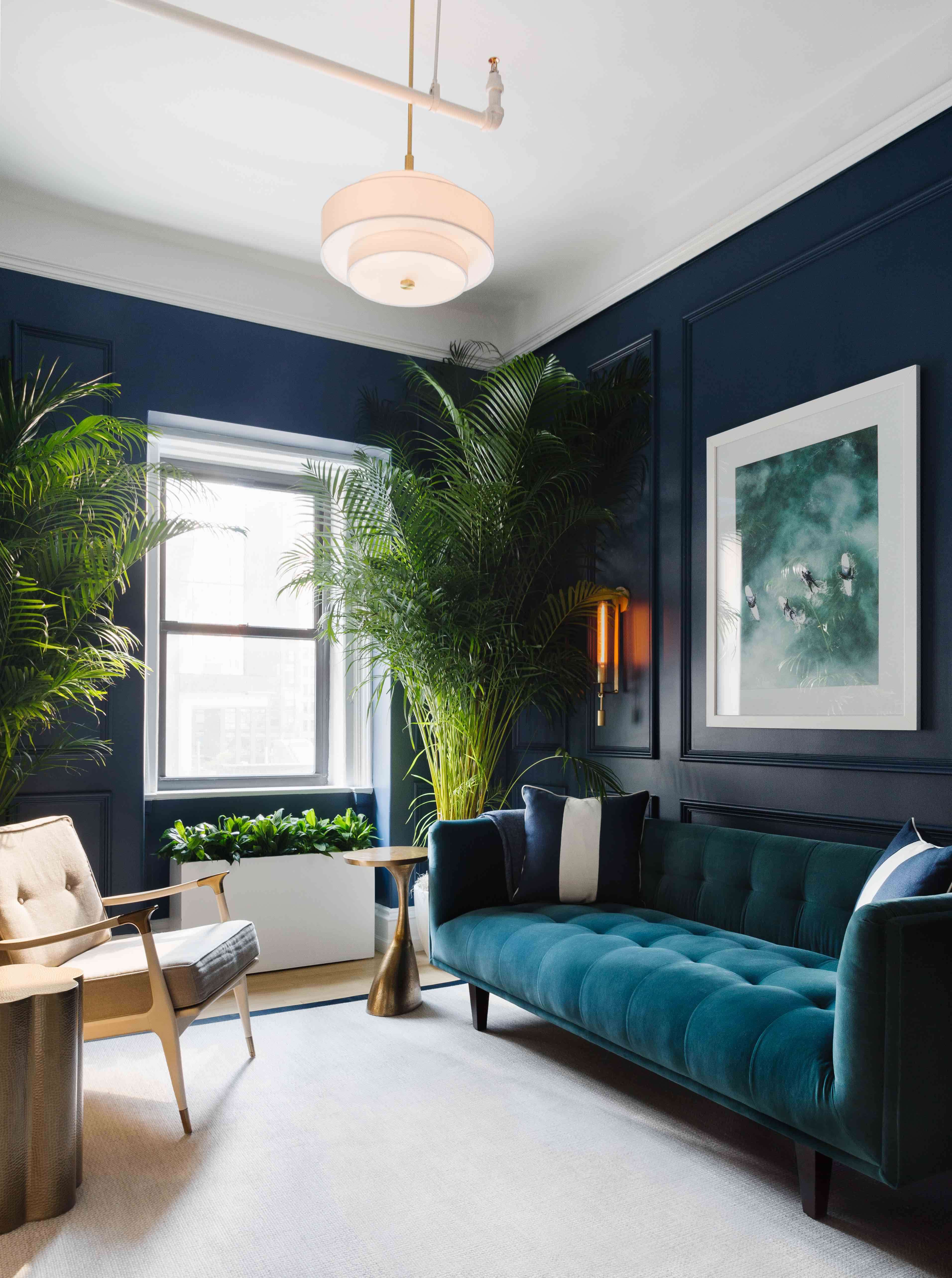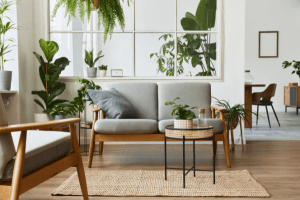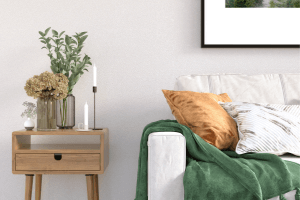
Your Therapy Office Essentials for Private Practice
When your clients first walk into your office, what do you want them to feel and experience?

A warm and intentionally-designed therapy office space can be a peaceful sanctuary for anxious or distressed clients.
Through your thoughtfulness about the care you took in creating a well-contained office, you communicate to your clients that you’ve put time and attention to detail into their experience from the moment they step foot in your door.
If you’ve been recently given the privilege of designing your own therapy office from the ground up, you might be extremely excited.
Or maybe you’re feeling incredibly intimidated — especially if you don’t think you have an eye for interior design.
Don’t underestimate yourself.
In this article, we’ll go through everything you need to know for designing a warm and welcoming space for your clients.
Cardinal Rules of Designing a Welcoming Therapy Office
Create Flow
The ideal space doesn’t hinge solely on decor. It also depends on how easily you can move through it.
A clear traffic flow helps make your office feel more inviting — if visitors can easily understand where they can walk towards seating, with pathways clear of obstructions, they’ll feel less awkward about navigating the space.
Here are a few tips to help you streamline your flow:
- Walk through every function of the space yourself to identify areas of traffic (e.g. pretend you’re a client about to sit down for a session, pretend that you’re coming in to file paperwork at your desk, etc.).
- Avoid putting furniture close to the door, which tends to make the space feel closed in.
- Remove all obstructions in the path between the door and your clients’ seating area.
- Push your clients’ couch or chair up against the wall. This can help them feel more grounded.
- Picture your floor plan from a bird’s-eye view to ensure you have clear traffic flow. If it looks odd on paper, then it likely is in real life.
Let the Light In
Natural light works miracles towards making a space feel warmer. It also doubles as a mood booster.
Wherever possible, make full use of windows and skylights and let the light in.
While as glorious as natural light is, you don’t want to be without curtains either.
My old office had wonderful floor to ceiling windows. Most clients loved it, while others commented that it made them feel unsafe and exposed.
It’s wise to have curtains for these clients. On the other hand, don’t block out the light with heavy blackout curtains — this can make your room feel stuffy. Use curtains that obscures the room from outside view with its transparency.
If your windows are at street level and open to a view of a busy road or sidewalk (complete with distracting sights and sounds), consider getting curtains that are thin enough to allow natural light to come through.
Serene, Soothing, and Timeless
You want your therapy space to feel reflective and tranquil.
In our office at Clarity Therapy NYC, we feature imagery of water and coastlines, which are universally enriching sources of healing and wellness. My thought was that just as the ocean is constantly changing, with its seemingly limitless horizons, as are we.
It’s wise to choose timelessness without sacrificing being modern. We chose natural shades of blue, white, gold, and green to elicit feelings of expansiveness, groundedness, and being harmoniously connected with nature.

Take Notes From Mother Nature
Bringing nature into your office can provide an exquisitely comforting and calming atmosphere.
Consider adding live plants, nature-themed art (e.g. paintings and decorative items) to help your clients relax in the space.
Hanging up a painting of a serene body of water, meditative gardens, or similar relaxing landscapes gives your clients a place to focus their attention toward when they feel overwhelmed.
Feel free to incorporate natural materials and colors in your other furnishings as well. Using soothing, natural colors like pale green or many shades of blue on your walls can make your space feel more calming. Many people also appreciate natural-colored wood with grain instead of sleeker surfaces (glass, chrome, etc.), which may feel impersonal.
Err on the Side of Minimalism
It can be tempting to fill your space to the brim with the decor you like (or think your clients will appreciate). However, it’s often best to stick to the “less is more” philosophy. You don’t want your office to feel bare and devoid of humanity, but you don’t want it to appear chaotic, uncontained, busy, or messy.
A clean space generally elicits positive feelings and thoughts of personal responsibility, respect towards yourself and your guests, and adaptive functioning.
A cluttered space may also make it difficult for clients to focus if they’re distracted by numerous knick knacks and decor.
Keep clutter to a minimum by choosing decor carefully.
And, make sure to clean regularly — even a fine layer of dust on your shelves can leave a negative impression of abandonment and neglect.
Therapy Office Design Starts by Starting with the Least Amount of Options First
When decorating any space, you generally want to start your design plan around essential and favorite pieces that have the most limited options.
For example, there are thousands of shades of paint to choose from, but only a few dozen options for appropriate chairs. You may love a piece as original and rare and unique as a favorite piece of art, or the design of a rug.
After you’ve selected your art, sofa, chair, rug, and pillows, you can choose any paint color to match!
In short, build your space around the most unique, limited pieces and expand from there.
Mix High and Low Design Items and Concepts
Strike a balance between high and low priced furniture.
For example, some of the pieces in our Clarity Therapy NYC office are Restoration Hardware, while others are from Wayfair.com.
Be mindful of displays of wealth. Be aware of how your office decor may impact your client based on demographic considerations.
If your work focuses on clients with more constructed finances, branded and expensive furnishings communicate certain messages regarding your own economic and personal circumstances and may create incongruence.
This can also be a projective. I remember some therapy associates of mine saying, “I don’t feel deserving of this room.” As you can imagine, we worked together to process this reaction and explored it further as we worked together to build their caseload.
You’re allowed to work in an office that feels harmonious and aspirational.
Even so, we always want to be mindful of intersectionality.
Another example of mindfulness in presentation is in how you dress. I generally wear professional clothes that are simple and without any logos. Logos and brands carry with them a certain valance.
It’s good to stay in the middle range — furnishings that are both aesthetically pleasing and reasonably priced.
Feel Free To Be Inspired By Others
If you struggle with being creative, feel free to hop on the internet and search for inspiration. If you see other therapist offices that you really like, go ahead and replicate them — after all, if it works, it works. Afterall, some of these design trends have global appeal. You can still add little tweaks of your own to personalize your office, which is less intimidating than designing it from scratch.
Don’t Be Afraid To Put Your Personal Touch
Given that your therapy office is still a place of business, it’s understandable that you want to draw a line between your professional and personal life. However, little touches here and there can help humanize you to your clients.
A favorite book, a photo from a previous vacation, a handmade present from a loved one — these glimpses offer a look behind your professional capacity as a therapist and can help foster a connection with your clients.
A strictly impersonal office can make clients feel uncomfortable and make it seem that you’re hiding who you are.
Therapy Office Essentials You Shouldn't Miss Out On
Now that we’ve gotten some general guidelines out of the way, here are some specific therapy office essentials to add to your shopping list:
The Couch
Your clients’ seating area is arguably the most important furnishing in your office.

During sessions, you want clients to feel comfortable and at home, both mentally and physically.
It doesn’t necessarily have to be a couch, but couches are more comfortable than chairs as they accommodate a wider range of seating or lying positions. Having a larger seating area for your patient is also body inclusive and body positive.
They also come in handy if you have sessions that involve more than one patient, such as in family and couples therapy. Observing clients’ body language in these situations can offer valuable insight.
You want to ensure your couch and chairs are comfortable, so feel free to splurge a bit.
(Also, a couch is also a great place to sneak a nap in between clients.)
Your Therapist Chair
Second only to your clients’ seating is your own. You’ll be sitting in this chair for hours upon hours, so be sure to invest in a durable and comfortable chair. It should also encourage good posture.
If you’re not comfortable in your seat, your clients might pick up on it during the session and become uncomfortable themselves.
A Personal Desk

A desk in your therapy office serves a practical purpose — you can get work done between clients and have a space to host virtual therapy sessions from.
It should be big enough to accommodate your needs but small enough that you can easily keep it organized.
If you want to incorporate more natural surfaces in your office, a natural wood desk is a great way to do so.
Lighting Fixtures
When you turn on the lights in your office, it shouldn’t lead to the place feeling like an interrogation room.
Avoid using only overhead fluorescent lighting, as this can cause eye strain and make clients feel like they’re in the spotlight.
Go for warm white or soft white light bulbs, as well as floor or tabletop lamps, to create a comfortable atmosphere.
Table and wall dimmers help maintain an ambient atmosphere any time of the day.
Wall Decor
Wall decor can be a positive distraction for your clients. Glances here and there can provide them with a welcome respite from talking about difficult issues.
You want wall decor that draws the viewer in and gives their brain a place to rest and reflect for a bit, such as art of peaceful and serene landscapes, tapestries with intricate patterns or textures, or shelves containing books or decorative objects.
The Rug
While it’s tempting to select a lighter rug to keep a space feeling more airy, I generally do not recommend getting light rugs or rugs with made with delicate, fussy materials.
I once had a rug with a silver sheen, and it would get absolutely destroyed any time it snowed or rained.
Going for commercial grade carpet at the beginning will save you the hassle of having to replace it. They generally survive more wear-and-tear, which is appropriate for high traffic spaces like the waiting room and a therapy office with clients coming and going every hour.
Today, with over 8 offices to maintain, I’ve discovered that indoor/outdoor rugs that are decorative are very easy to clean in the event of a spill or scuff marks. Wayfair has some excellent options of various shapes and sizes that are reasonably priced and often in stock and delivered within a week.
If you ever need to replace the rug, it’s less expensive than a traditional rug.

Hard-To-Kill Houseplants
Plants are an easy, effective way to liven up any indoor space. They improve indoor air quality and provide a nice bit of natural color.
If you don’t have a green thumb, be sure to look for low-maintenance plants — a neglected, wilted, or dying plant won’t leave clients with the best impression.
Monstera, in particular, is known for being resilient. It grows quickly, can survive without much sunlight, and is relatively easy to care for.
The Clock
While they’re essential to help you keep the frame of therapy and manage your time, it helps clients to also have view of a clock during session so that they can pace themselves.
The last thing you want is to be awkwardly trying to end a session with a client when they’re in the midst of deep exploration and feeling. You also don’t want to create unnecessary stress running over, or worse, cutting into your next clients session.
I also advise against getting smart device clock displays. I once had an aesthetically appealing Amazon clock. Unfortunately, most of them now have cameras which can be hacked, and there’s no guarantee that companies like Apple and Amazon aren’t sending audio data collected from any room and sending it back to HQ.
Instead, stick with conventional analog or digital display clocks that don’t connect to a Wi-Fi network.

Soft Elements
Pillows, blankets, rugs, curtains, wall hangings, and other soft textiles can help make your space feel cozier and make it easier to build trust.
For example, a soft pillow on your couch can be a welcome grounding sensation for clients.
A thick rug can help dampen sound in the room. If you work with children, stuffed toys can be a great way to get them comfortable in the space.
Other Decor Items To Consider
Here are some items that you don’t necessarily need, but can further improve your space all the same:
Tables: Coffee Tables, Side Tables, End Tables
Tables aren’t strictly necessary when you’re just sitting across from someone to talk to them, but they’re often much appreciated. Putting a table near your couch gives your clients a dedicated place to put their belongings down and gives them more space to occupy during a session. This demonstrates that you’re mindful of their comfort and convenience and the space is as much theirs as it’s yours.
Your Credentials
Studies have shown that clients appreciate seeing proof of your expertise. It solidifies your trustworthiness and demonstrates that you’re a qualified, trained professional with the credentials to back it up.
Bookshelves
Bookshelves pull double duty in aesthetics and practicality — they look good visually and they help you keep your reference texts and other materials organized.
Having a few interesting items nested can also make for great conversation starters with your clients.
A Box of Tissues Cover
So, a decorative tissue holder isn’t a necessity, but can still be nice to have, especially if it adds a bit of life to your office. What is a necessity, however, is the box of tissues underneath.
Don’t forget to stock up now and then again and again — it can’t hurt to be over-prepared. The last thing you want is for a client who is in touch with deep feelings to be without tissues.
Looking To Swap Interior Decor Tips With Other Therapists?
Even with a list of therapy office essentials in hand, you might still not feel like you’re ready to decorate your office space.
At the Cooperative, we provide you with an online platform equipped with everything you need to grow your business — an active community of other therapists around the nation, essential tools and resources, and guidance from industry experts.
Share your thoughts in our community
www.wayfair.com
https://www.thespruce.com/best-indoor-outdoor-rugs-4155734#:~:text=Indoor%2Doutdoor%20rugs%20are%20made,any%20large%20dirt%20and%20debris.
https://smartgardenguide.com/hard-to-kill-houseplants/
https://www.mcgovernproject.com/
https://www.revistaad.es/espacios/oficinas/galerias/un-espacio-dedicado-al-bienestar-en-el-corazon-de-nueva-york
NYC Therapy Office Rental Solutions for Psychotherapists: Select Office Suites In the mental health field, where compassion and professionalism converge, we can’t overlook the value of having an office space to conduct in-person
Why Does Your Private Practice Website Need Therapist Headshot Photos? How often do we consider the power of a single image in shaping our perception of a professional? A picture is worth a thousand words – and that saying goes for your therapist headshot, too.
As a mental health professional, your primary focus is likely on taking care of your clients. But to do that, you first need to form a strong connection with them. To do that in today’s moder


Become a Member
Get everything you need to build a thriving private practice.

